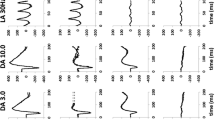Abstract
Classical electromagnetic theory is used to examine the topographical variation in electrical potentials over the corneal surface resulting from specific retinal stimuli. Results from a three-dimensional mathematical model show that over 97% of calculated electromagnetic field potentials lie within 3% of previous analytical model data for an axially symmetric case. Maps of corneal potentials are produced that are shown to be characteristic of specific retinal stimuli and location. The maximum variation in corneal potential for a full field global stimulus is found to be approximately 1%. This is considered encouraging, as current electrophysiology techniques measure ocular potentials from a single corneal or scleral site, the position of which is often difficult to localise and reproduce. The model is used to simulate both central and peripheral stimuli and scotoma conditions. A 20° central scotoma simulation shows an overall reduction in central corneal potential of only 3%, whereas peripheral stimuli are found to cause up to 10% variations in this potential. There is therefore a possibility that a single recording site for multifocal retinal stimulation is not ideal. These data may be used to suggest more appropriate electrode recording positions for maximum signal recovery, not least in optimising signal detection for multi-focal electroretinography stimulation.
Similar content being viewed by others
References
Barber, C. (1994): ‘Electrodes and the recording of the human electroretinogram (ERG)’,Int. J. Psychophysiol.,16, pp. 131–136
Curcio, C. A., Sloan, K. R., andMeyers, D. (1989): ‘Computer methods for sampling, reconstruction, display and analysis of retinal whole mounts’,Vis. Res.,29, pp. 529–540
Doslak, M. J. (1978): ‘The effects of variations of the conducting media inhomogeneities on the electroretinogram’. PhD thesis, Case Western Reserve University, Cleveland, Ohio
Doslak, M. J., Plonsey, R., andThomas, C. W. (1981): ‘Numerical solution of the bio-electric field of the ERG’,Med. Biol. Eng. Comp.,19, pp. 149–156
Doslak, M. J., andHsu, P. C. (1984): ‘Application of a bioelectric field model of the ERG to the effect of vitreous haemorrhage’,Med. Biol. Eng. Comp.,22, pp. 552–557
Doslak, M. J. (1989): ‘Quantitative analysis of the insulating effect of silicone oil on the electroretinogram’,Med. Biol. Eng. Comp.,27 pp. 254–259
Frank, E. (1952): ‘Electric potential produced by two point current sources in a homogeneous conducting sphere’,J. Appl. Phys.,23, pp. 1225–1228
Fricker, S. J., andSanders, J. J. (1974): ‘A new method of come electroretinography: the rapid random flash response’,Investig. Ophthalmol.,14, pp. 131–137
Geddes, L. A., andBaker, L. E. (1967): ‘The specific resistance of biological material—a compendium of data for the biomedical engineer and physiologist’,Med. Biol. Eng.,5, pp. 271–293
Hood, D. C., Greenstein, V., Frishman, L., Holopigian, K., Viswanathan, S., Seiple, W., Ahmed, J., andRobson, J. G. (1999): ‘Identifying inner retinal contributions to the human multifocal ERG’,Vis. Res.,39, pp. 2285–2291
Keating, D., Parks, S., Evans, A. L., Williamson, T. H., Elliott, A. T., andJay, J. L. (1997): ‘The effect of filter bandwidth on the multifocal electroretinogram’,Documenta Ophthalmologica,92, pp. 291–300
Krakau, C. E. T. (1958): ‘On the potential field of the rabbit electroretinogram’,Acta Ophthalmologica,36, pp. 183–207
Krause, A. (1934): ‘The biochemistry of the eye’ Balitmore: The Johns Hopkins Press 1934. Cited by Sundmark, E. (1959): ‘The Contact Glass in Human Electroretinography’,Acta. Ophth. Suppl.,52, pp. 1–40
Ogden, T. E., andIto, H. (1971): ‘Avian retina. II An evaluation of retinal electrical anisotropy’,J. Neurophysiol.,34, pp. 367–373
Parks, S., Keating, D., Evans, A. L., Williamson, T. H., Jay, J. L., andElliott, A. T. (1997): ‘Comparison of repeatability of the multifocal electroretinogram and Humphrey perimeter’,Documenta Ophthalmol.,92, pp. 281–289
Plonsey, R. (1984): ‘Quantitative formulations of electrophysiological sources of potential fields in volume conductors’,IEEE Trans.,BME-31, pp. 868–872
Straatsma, B. R., Hall, M. O., Allen, R. A., andCrescitelli F. (Eds.) (1969): “The retina’ (University of California Press, Los Angeles)
Sutter, E. E., andTran, D. (1992): ‘The field topography of ERG components in man-1. The photopic luminance response’,Vis. Res.,32, pp. 433–446
Sutter, E. E., andBearse, M. A. Jr. (1999): ‘The optic nerve head component of the human ERG’,Vis. Res.,39, pp. 419–436
Wolff, E. (1976): ‘Anatomy of the eye and orbit’ (Hodder & Stoughton Publishers, 1997)
Author information
Authors and Affiliations
Corresponding author
Rights and permissions
About this article
Cite this article
Job, H.M., Keating, D., Evans, A.L. et al. Three-dimensional electromagnetic model of the human eye: advances towards the optimisation of electroretinographic signal detection. Med. Biol. Eng. Comput. 37, 710–719 (1999). https://doi.org/10.1007/BF02513372
Received:
Accepted:
Issue Date:
DOI: https://doi.org/10.1007/BF02513372




